Getting to School Safely - Walk, Bike, or Ride
Going to school is a normal part of childhood, but transportation to school requires planning and collaboration between parents and children. Many parents drive their children, believing it is the only safe means to get them to school. However, walking, biking, or riding the bus is not only beneficial but possibly even safer for your child.
Going to school is a normal part of childhood, but transportation to school requires planning and collaboration between parents and children. Many parents drive their children, believing it is the only safe means to get them to school. However, walking, biking, or riding the bus is not only beneficial but possibly even safer for your child.
Walking to School
Allowing your child to walk to school alone for the first time can be scary, but knowing your child is ready and ensuring the route is safe will provide you with peace of mind.
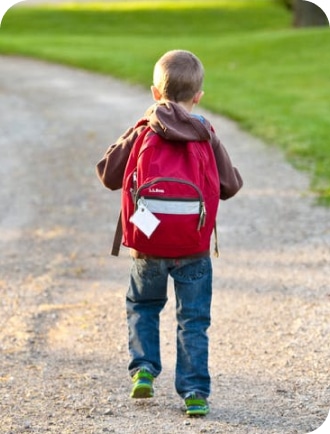
Identifying Safe Routes to School
Your child’s route must be pedestrian-friendly. Areas along highways that lack sidewalks or other safe walking areas, as well as high-traffic areas with speed limits over 50 mph, are too hazardous. Also, choose a route that has no secluded areas.
Walking Distance
As a rule, the younger the child, the shorter the walking distance should be. Children over 12 may be reasonably capable of walking up to two miles, but younger children will need short, simple routes.
Your Child’s Readiness
The American Academy of Pediatrics (AAP) recommends waiting until children are around ten years old before allowing them to walk to school alone. The AAP found in studies that children this age are more adept at identifying safe places to cross and detecting danger.
All children are different. If your child feels uncomfortable walking alone or is not mature enough, it is better to wait. If possible, walk to school with your child or let your child walk with a more mature child or trustworthy adult until he is ready. Walking to school even a few times per week can be beneficial.
Safety Checkpoints
If you know trustworthy individuals who live along the route your child takes to school, let them know your child is walking and ask them to make sure your child passes their home at the right time each day. Your children should also know where these houses and safe public areas are so that if they ever need help, they know where to get it safely.
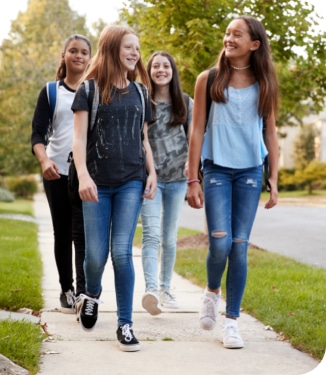
Instill Safe Habits
Walking with your child to school will ensure your child becomes familiar with the route and allow you to teach and model the following important safety habits:
- Use sidewalks, or walk as close to the side of the road as possible against traffic when sidewalks are unavailable.
- Be aware of who and what is in front of, beside, and behind them.
- Watch where they are going and avoid looking at their cell phones while walking.
- Keep the volume low if using earbuds or headphones.
- Remove headphones or earbuds before crossing the street.
- Only cross the street at intersections.
- Avoid pushing, shoving, and horseplay when walking to school with friends.
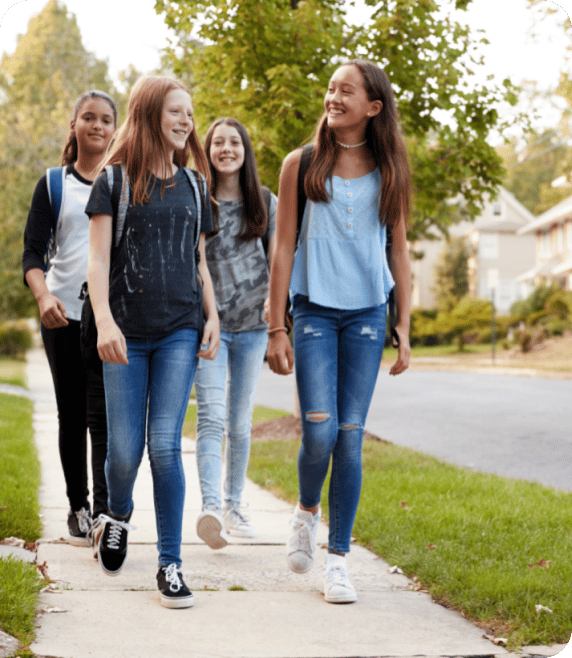
Crosswalks
Make sure your child understands how to use crosswalks and what the symbols mean:
- Solid pedestrian symbol - It is safe to cross.
- Flashing orange hand - Finish crossing, but do not initiate crossing.
- Solid hand - It is not safe to be anywhere in the intersection.
Teach your child that, even if the symbols say to walk, they must look both ways to ensure traffic has stopped and watch for people turning right or left onto the road they are crossing to prevent pedestrian accidents.

Strength in Numbers
Pairing your child with another safety-informed child can add to their safety. You may also find a group of children in your neighborhood who would like to walk to school.
A walking school bus is a group of parents and students that walk to school together, with neighborhood children joining the caravan as it passes their homes until they arrive at school as one large group.
Walking as a group increases visibility, creates bonding opportunities, and makes the walk more enjoyable.
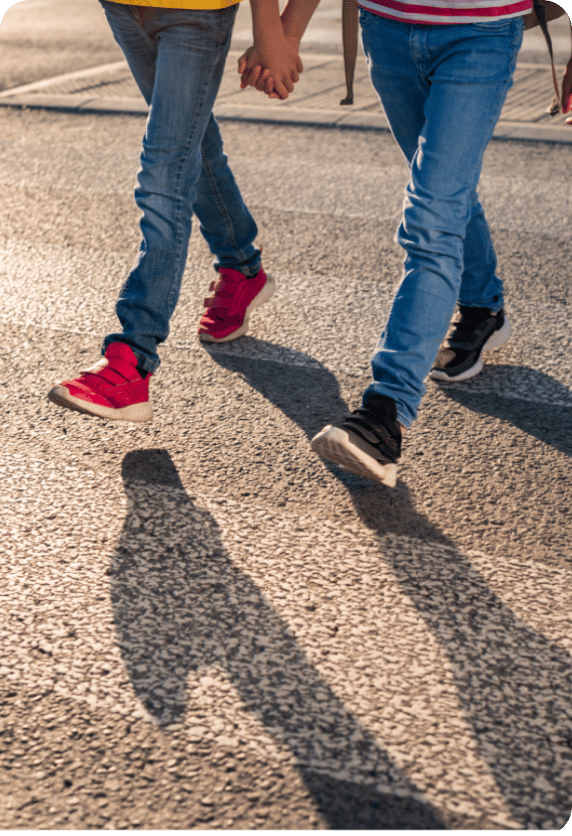
Stranger Danger
Child abduction is every parent’s greatest fear and a primary reason many children do not walk to school. Stranger abductions are rare, with just 100 per year in the United States. Children are approximately seven times more likely to be killed in a car accident. However, the concern is valid, and children should be taught to keep themselves safe.
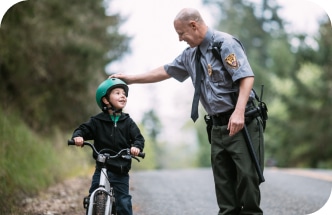
What is a stranger?
In addition to people they have never seen, slight acquaintances are strangers. A slight acquaintance is anyone who the family or child:
- Has known for less than six months
- Has known longer than six months but sees less often than monthly
- Has seen before but does not know by name
Teach your child to run from strangers who initiate contact with them, and make them aware of the common ruses strangers use to entice children, including:
- Kittens or puppies
- Candy or gifts
- Saying “Your parents told me to pick you up.”
Tell your child not to approach or accept anything from strangers. Inform them of who would pick them up if there is ever an emergency. Establish a code word that trusted adults must provide before the child goes with them.
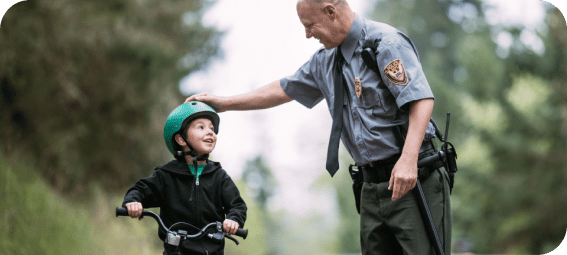
Teach your children the following
- You will not send a stranger to pick them up.
- Dangerous strangers sometimes know children’s names.
- It is okay not to be polite to strangers.
- If someone tries to grab them, they should scream and yell, “This is not my dad,” fight, kick, bite, and run.
Encourage your children to trust their instincts when they have a bad feeling. Tell them to find the nearest safe stranger, such as a police officer, crossing guard, or another uniformed adult on duty, or a public building and call you or 911 if they believe someone is following them.
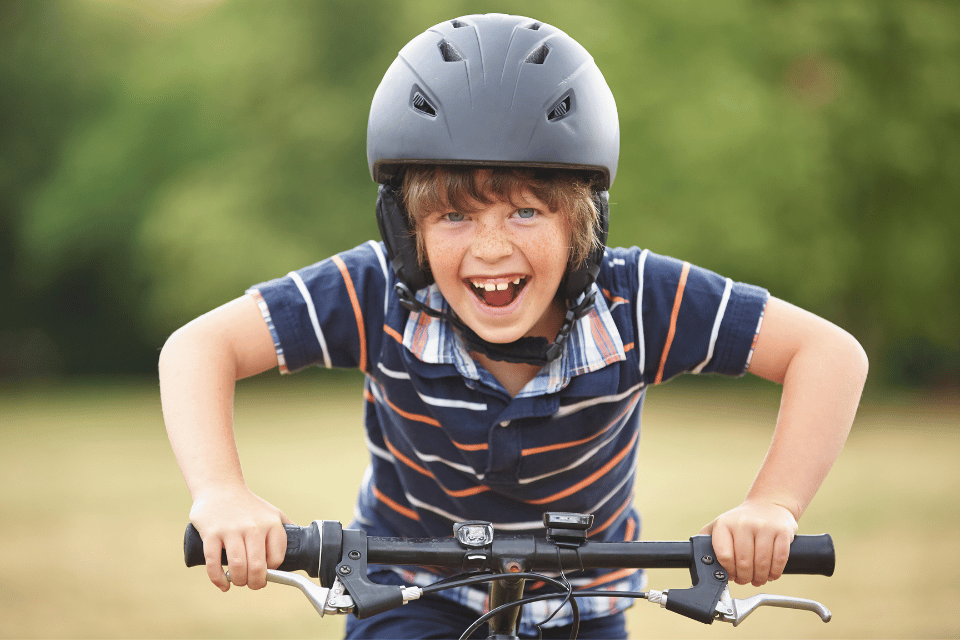
Biking to School
Riding a bicycle to school provides the same exercise benefits as walking, with a faster way to cover longer distances.
Make sure your child’s bicycle route meets the following safety standards:
- Low to moderate traffic
- Bicycle lanes or wide shoulders
- No high-volume intersections, unless they have crossing guards
- No secluded areas
Your child should have a secure bicycle lock that thieves cannot cut, such as a U-lock or high-quality cable lock. Your child should know how to secure the bicycle by the frame and not just the tire to a secure structure, such as a bicycle rack at the school.
How to Ride Your Bike Safely
The first step in ensuring a safe ride is providing the correct equipment:
- A correctly sized bicycle. Your child’s feet should touch the ground when they sit on the seat.
- A well-fitting helmet. This is required in most states. The helmet should be positioned on top of the head in a level position.
Before each ride, you and your child should do the following until you can trust your child to do it on his own:
- Check the brakes, chain, reflectors, gears, and tire pressures.
- Make sure the child is not wearing loose clothing that could get caught in the chain or wheel spokes.
Teach your child that riding a bicycle to school is a significant responsibility that requires following your rules as well as traffic laws.
- Bicyclists are required to follow the same traffic laws as motor vehicles and stay as close to the right as possible.
- Many states do not allow bicyclists to use sidewalks.
- Use hand signals when preparing to turn or slow down.
- Wear brightly colored clothing or neon strips to increase visibility to motorists.
- Obey stop signs and traffic lights.
- Yield to other drivers and assume drivers cannot see you until they make eye contact.
- Watch for left- or right-turning traffic.
Even if your young bicyclist does everything correctly, things can go wrong. They could experience a bicycle accident or flat tire. Discuss the plan of action if this occurs.
An action plan could consist of any of the following:
- Secure the bicycle in a safe place and walk the rest of the way to school.
- Call the parent or another designated adult to provide transportation to school and pick up the bicycle.
School Bus Safety
According to the National Highway Traffic Safety Administration, students who take a school bus are 70 times safer than those who ride to school by car.
What makes school buses safer than cars?
School buses have numerous safety features and regulations for the protection of children.
Driver Training
School bus drivers are required to undergo background screenings and extensive training prior to and throughout their driving careers. They are commercial drivers who must abide by high standards of conduct imposed by federal and state law as well as individual school policy.
High Visibility
The size, lights, familiar markings, and characteristic yellow color make school buses highly visible in traffic, so drivers are more likely to notice them.
Loading and Unloading Procedures
School bus drivers and other drivers are required to follow strict safety protocols while children are boarding and exiting the bus. The bus driver turns on the amber warning lights while approaching a stop. When the bus door opens, flashing red lights and a stop arm are activated. Drivers going both directions are required by law to stop.
Bus drivers are trained to ensure passengers have safely left the street before leaving a stop.
Crash Protection
Buses are built with protective characteristics to reduce crash forces, including:
- The size and weight of the bus
- The closeness and strength of the seats and the energy
absorbing seatbacks (large buses) - Seat belts (small buses)

Bus Stop Safety
A school bus is a large vehicle with significant blind spots near the bus’s front, sides, and rear. Children should stay in the designated bus-stop area, avoid horseplay, and abide by the National Safety Council’s rules of safety:
- Arrive at least five minutes early. Do not try to run and catch the bus.
- Stay at least six feet away from the curb while waiting for the bus.
- Do not approach the bus until it comes to a complete stop and the driver opens the door.
- Cross at least ten feet in front of the bus, and wait for the driver to signal that it is safe to cross.
- Never cross behind the bus.
- Never pick up a dropped object near the bus without first asking the driver.
Behavior on the Bus
Children’s behavior on the bus impacts everyone’s safety. The seats offer crash protection only when children are seated properly, facing the front, with arms and legs out of the aisles.
Backpacks and other possessions should be contained within the seating area, not in the aisle.
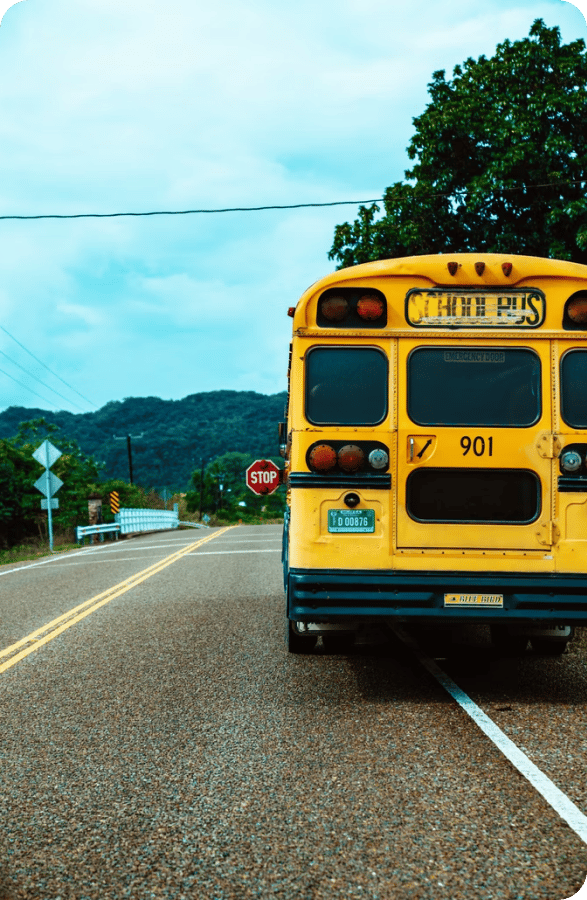
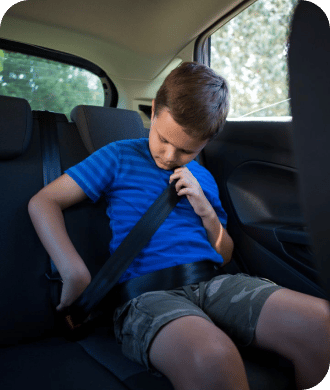
Riding in Car to School
Sometimes driving your child to school is the only option or the best option for your family.
Transporting your child to school every day can be challenging when it competes with a work schedule. In these cases, carpooling might be an option.
Carpooling allows parents to share transportation responsibilities, saving time, gasoline, and the environment. The most important caveat with carpooling is to ensure you know and trust the other parents in the carpool.
Organizations such as My School Carpool help parents arrange safe carpooling groups in their local areas and even provide background screening.
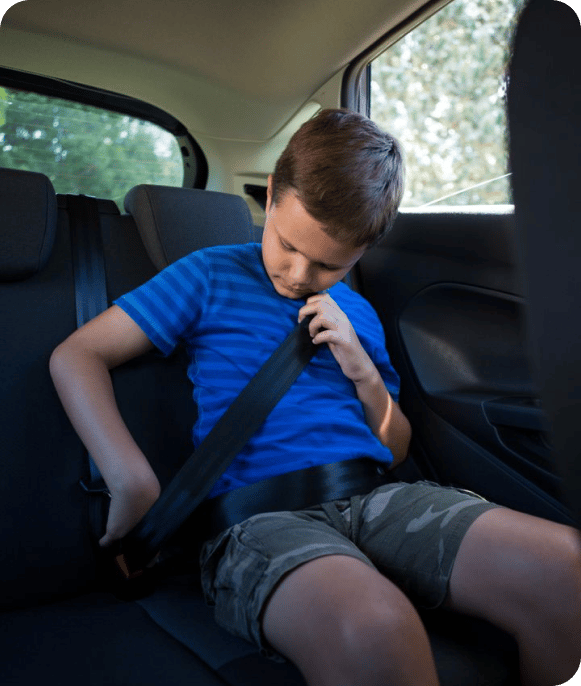
Car Seats
Car seats and booster seats provide important protections in car accidents for children who are too small to benefit from seatbelts.
The requirements vary slightly from state to state, but NHTSA offers the following general guidelines.
Ages four to seven
Use a forward-facing car seat with a harness and tether until the child outgrows the car seat as indicated by the manufacturer. At that point, use a booster seat with a harness and tether.
Ages eight to twelve
Use the booster seat until the child can fit a seat belt properly. A properly-fitting seat belt fits snugly across the thighs but not the stomach. The shoulder belt should fit snugly across the shoulder and chest but not the neck or face.
All children under twelve should ride in the back seat.

Tips for Adult Drivers
While driving during school rush hours, keep the safety of school children in mind. Leave early enough to allow for the delays school traffic creates. Children are not always as careful as they should be, so drivers must watch for them.
- When preparing to back out of your driveway, check for kids before you get into your car and again before you start.
- Use your mirrors and back out slowly.
- Drive below the speed limit.
- Pay special attention in and near school zones.
- Do not block the crosswalks when stopped at a red light or waiting to turn.
- Stop for crossing guards, and do not try to hurry through intersections.
- Always stop when school buses are loading and unloading, even if their red flashers are not on.
- Be alert to children darting out suddenly.
- Watch for bicyclists and give them plenty of space.
And, as always, when operating a motor vehicle, avoid distracting activities such as talking on your cell phone, eating, or playing with the radio.